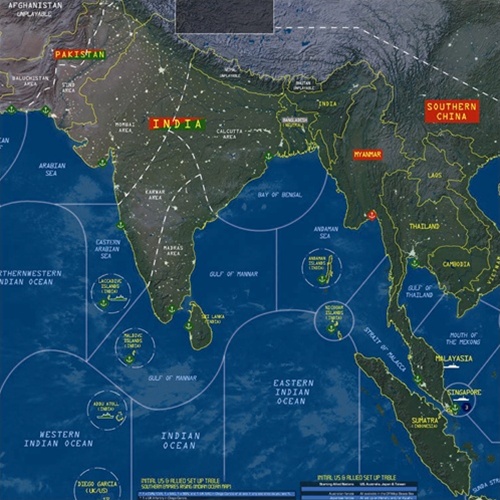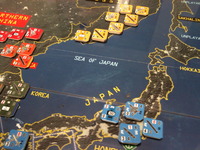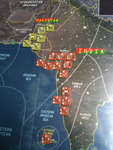|
|
Red Dragon – Green Crescent Naval warfare in the 21st Century La serie “Modern War” è stata segnalata un paio di mesi fà su queste pagine, ma in occasione della recensione del “Libro del mese” che riguarda la situazione strategica nella zona della Cina, credo sia interessante un approfondimento sul titolo che permette di simulare un ipotetico conflitto in quell’area. Introduzione Red Dragon/Green Crescent (RDGC) è un gioco a livello strategico che copre un ipotetico conflitto futuro nella parte sud ed est della periferia asiatica. Progettato su una situazione proiettata negli anni 2013-2021, è assolutamente interessante per studiare questo non auspicabile conflitto! La simulazione trae origine da un precedente titolo pubblicato sul n. 250 di S&T; l’autore è Bruce Costello. Il gioco è adatto in solitario, per due giocatori e per multiplayer. Questa edizione espande il gioco originale e comprende ora anche il Medio Oriente e l’Oceano Indiano che oggi sono strategiche sia per gli USA che per la Cina e suoi alleati. La simulazione prevede l’utilizzo di forze cinesi e americane in gran numero oltre alle marine e aviazioni di Australia, Francia, India, Iran, Italia, Pakistan, Giappone, Malesia, Nord Corea, Sud Corea, e tante altre; una rappresentazione molto completa delle potenziali forze in campo! In effetti ci sono alcuni scenari di base ma le varianti sono talmente tante che il gioco ha possibilità infinite. Mappe Le mappe sono 2, di grandi dimensioni e a zone; la grafica è quella “da satellite”, in pratica una foto con evidenziati i confini nazionali e la suddivisione in zone. Sono stati aggiunti, poi, porti, basi navali, controlli di ampie zone terrestri, ecc. L’effetto generale è ottimo e rende molto “professionale” il gioco; le zone sono generalmente ampie quindi non ci sono problemi per lo stacking. Pedine/counters Due i countershet per un totale di 556 unità, che presentano pedine di dimensioni “grandi”, molto chiare e maneggevoli e con grafica molto bella e chiara. Molte, naturalmente, le unità USA e Cinesi, oltre a unità navali ed aere di nazioni quali Inghilterra, Francia, Italia, Pakistan, India, Iran, Russia, ecc. In pratica, i maggiori arsenali delle potenze mondiali! Most of the ground units in RDGC represent brigades (“brigade combat teams” or “BCT” for the US). The exceptions are the Singaporean, Malaysian, Taiwanese, Philippine, and Yemeni armies. There is additionally one new corps of marines for the PRC. Aircraft are mostly represented by mixed-type combat-wings, though only one aircraft type is shown on each counter. Long-range bombers have their own mono-type units that can’t combine operations with the other ‘tactical’ air wings. Ship units mostly represent mission-oriented groups of vessels such as SAGs, subrons or individual capital ships. Regolamento Modern War offre, all’interno della rivista, un set di regole del gioco inserito. Per RDGC le pagine sono 32 ma solo le prime 20 sono di regole, mentre il resto sono scenari e l’elenco dei vari eventi casuali oltre alla spiegazione delle numerose azioni che un giocatore può svolgere ogni turno. Molto chiaro, di difficoltà media. Conclusioni Modern War è un prodotto ottimo, specie per gli appassionati del periodo contemporaneo; RDGC offrirà ore di puro divertimento agli acquirenti!
|
| Da BGG, un’interessante recensione di Matt Irsik:
I have always had a love-hate relationship with magazine wargames. They always sound so appealing in the ads, but once they arrive, get set up and played, they usually end up going on Ebay or in the trade pile. That’s usually because they are under-developed, there’s not much time for playtesting, and because of the limitations on counters/maps, things that the game needs have a tendency to get left out. Over the last ten years I’ve probably purchased well over thirty magazine games and have kept only a handful. One of those I did keep was a modern warfare offering called Red Dragon Rising. Despite the garish colors of the map and a few rules problems, it was a fun game that had fantastic replay value. I was pleasantly surprised that there would be a newer version that would include the Indian Ocean and Persian Gulf areas called Red Dragon/Green Crescent that would be the first issue in a new magazine/game series called Modern War. Overview Red Dragon/Green Crescent (RDGC) is a theater level game focusing on naval and air operations from the Persian Gulf to the Western Pacific. The game assumes an attack by the People’s Republic of China (PRC) along with Pakistan and Iran (depending upon scenario) on the United States and its allies. There are ground units, but they are usually marine brigades, special forces, etc., that would be used to seize control of islands or port areas. Major ground combat, such as a second Korean War, is handled abstractly. The players are in the role of commanding a wide variety of naval and air assets, from carriers to surface action groups to squadrons of aircraft across vast expanses of the world’s seas. The game features an interesting sequence of play that focuses on random events and the “Op” or Operations, where players get to choose from a list of actions. This definitely enhances the replay value of the game and produces enough chaos where the players need to not only react to their opponent’s moves, but to a constantly changing global situation. Components The single map of East Asia that was in Red Dragon has been expanded to two maps with the second map reaching all the way to the Persian Gulf. Also, the Red Dragon map has been turned ninety degrees to fit both maps together. The color choices for the map are interesting, but they work and the sea areas, islands, etc., are clearly marked. I do take issue with the large holding boxes (could have been used for random event listings), the colors used for the Op lists (kind of annoying to read), and the set up listings again should have been replaced by the random event listings. Random Events and Ops drive the game, so they should have been clearly listed on the map if there was room. Failing that, why not use the extra room for a turn track and/or victory point track? Also, the stacking numbers for some island groups are missing and there’s a box with what the numbers on the counters mean, but it looks like there was space for a counter graphic to go in the middle, but there’s nothing there. Game Play Probably thcial e greatest praise for wargame designers is saying that their game works, and in this case it is true. RDGC works…as a game, not as a simulation of modern combat. Each turn begins with the player rolling to see if there is a random event. On a 1 or a 2 the player rolls again and consults the event listings for the effect. These range from countries dropping out of the war, reinforcements needing to be sent elsewhere, revolts, and much more. This is one of the strong points in the game that keeps players guessing and increases the replay value of the game. Then players choose an Op from the list as their action for the turn. Ops can be moving a group of units from a land base out to sea, long range strikes by TU-22s or B-2s, air attacks on enemy bases, calling for reinforcements, hyper war chit draws, and much, much more. In fact, this new version has added even more Op actions than the original Red Dragon Rising so that choosing one can be difficult. Movement and combat are done by areas with forces being able to usually move one area per Op. This is also one of them main challenges for players in that they can only choose one Op per turn. You have so many units, tasks, needs, etc., that choosing just one is difficult to say the least. Scenarios & Campaigns
Replay Value Simply put, off the charts. With the large number of random events, multiple Ops to choose from, and several paths to victory for the Chinese player, this is a game that can be played over and over. One of my friends and I once did three games in just under three hours! Once you know the system you can get through the turns pretty quickly. Not only that, certain events can end the game well short of the 30 Op limit. I’ve played about a dozen games of Red Dragon Rising along with several of the others in the combined game and there’s been numerous surprises along the way, ranging from Taiwan dropping out on the first two turns (makes things really difficult for the U.S. player) to a massive Russian-Japanese sea battle that saw both fleets get cut down to almost nothing. The great thing about RDGC is that you never know what’s just around the corner.
Summary Despite some small issues with components and the rules, this game is worth playing. The Red Dragon side of the game is what you’re spending the money for and it is a very good game. Both sides have a ton of options, there’s a lot of action, and if things go really wrong you can quickly set it up and play it again. We’ve had some tremendous battles and a lot of fun along the way. However, when you add in the second map and units, I’m not sure what it is adding to the overall game. Because of the op limitations expressed above, you simply have too many units that need to do too many things, but the players are limited to doing just one thing per turn per map. Something is not right here and while it succeeds as a game, I’m not sure that it succeeds as an accurate portrayal of modern naval and air combat. I’m sure many players are going to think at some point, “So, I’m moving some heavy U.S. ground units from the holding box in a convoy to help Taiwan, so for the next several turns everything else I own across that map has to sit still?” Yes, it does and that is a problem that may be too high of a hurdle for some gamers to get over. Again, however, RDGC succeeds in its game play. The random events, chaotic nature of combat, and large number of choices through Ops and various units that you can use each turn makes this into a challenging game. I think more effort, development, and playtesting needed to go into the combined game as there are a number of issues for the Indian Ocean/Persian Gulf map. Overall, a good, but not great start for Modern War magazine.
|
|
| € 30,00 |
Strategy & Tactics Press
|
Ottobre 2013: Red Dragon – Green Crescent






